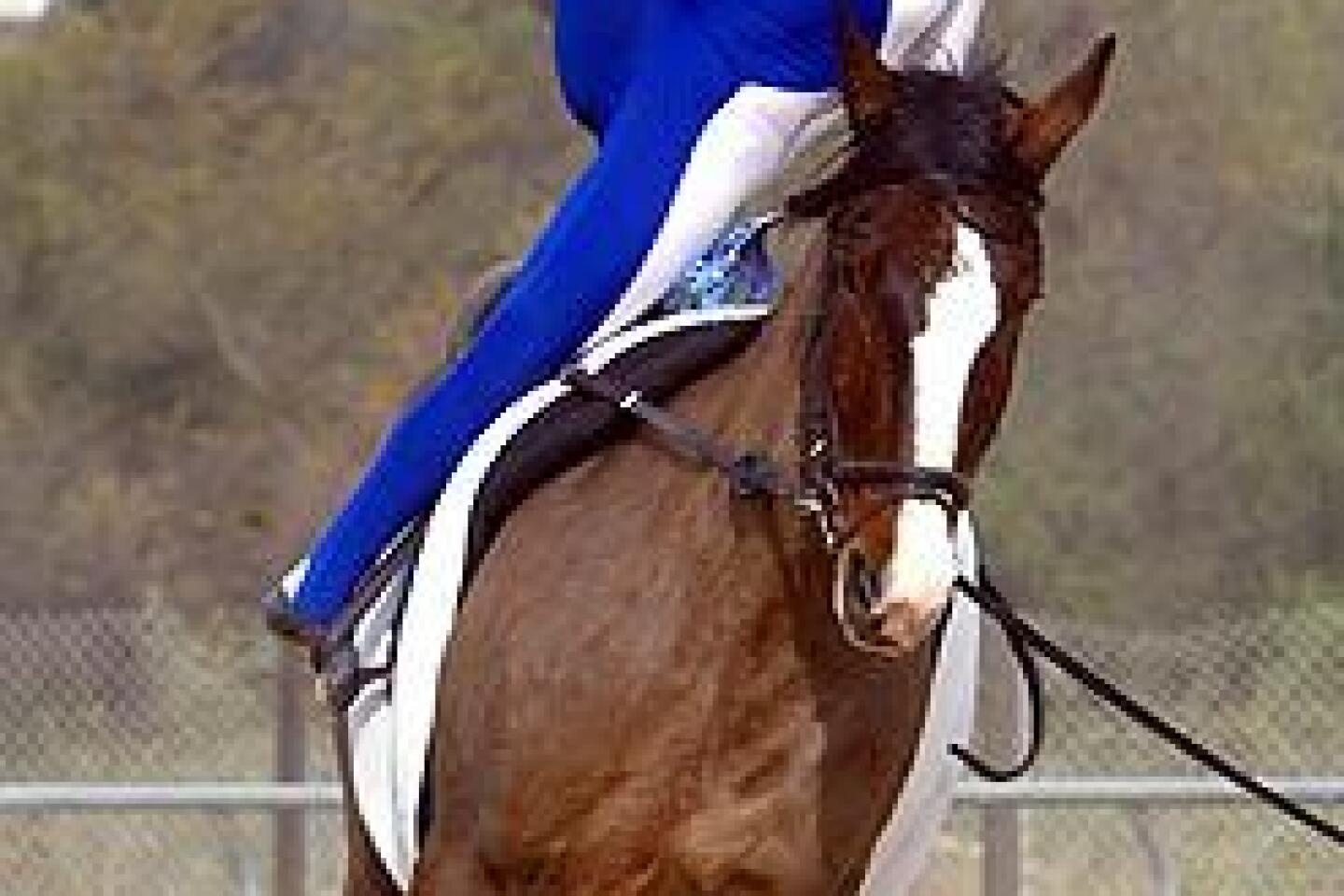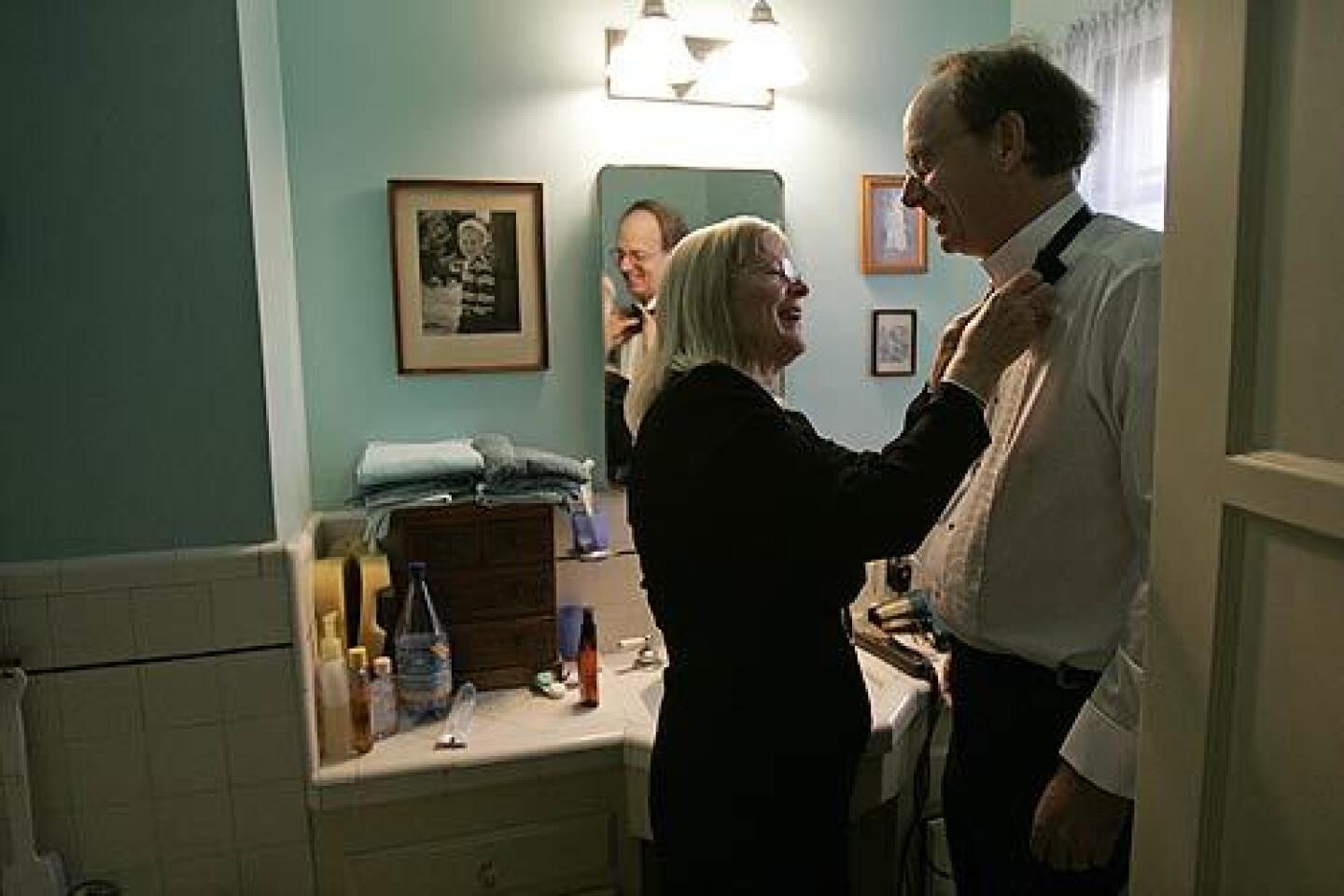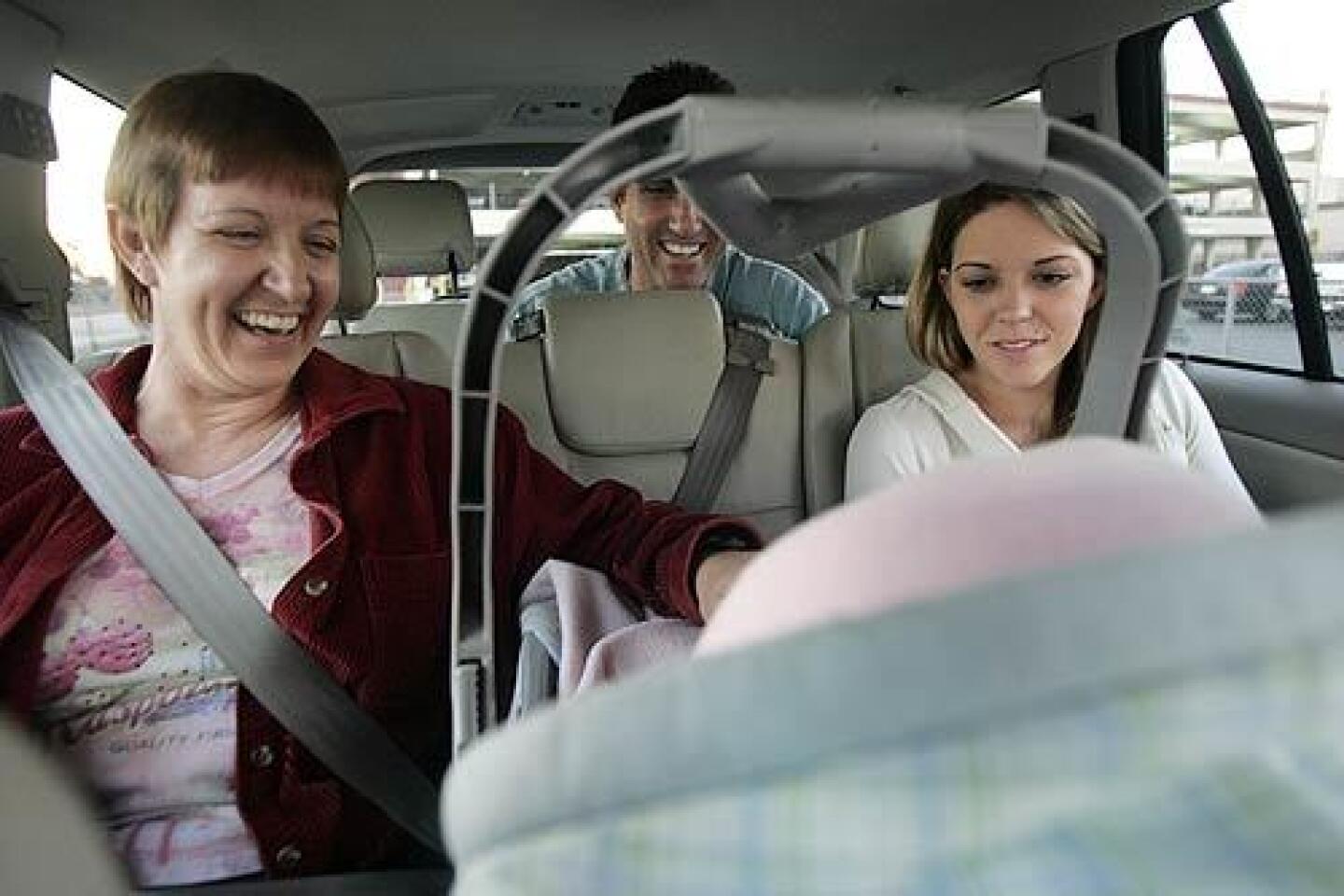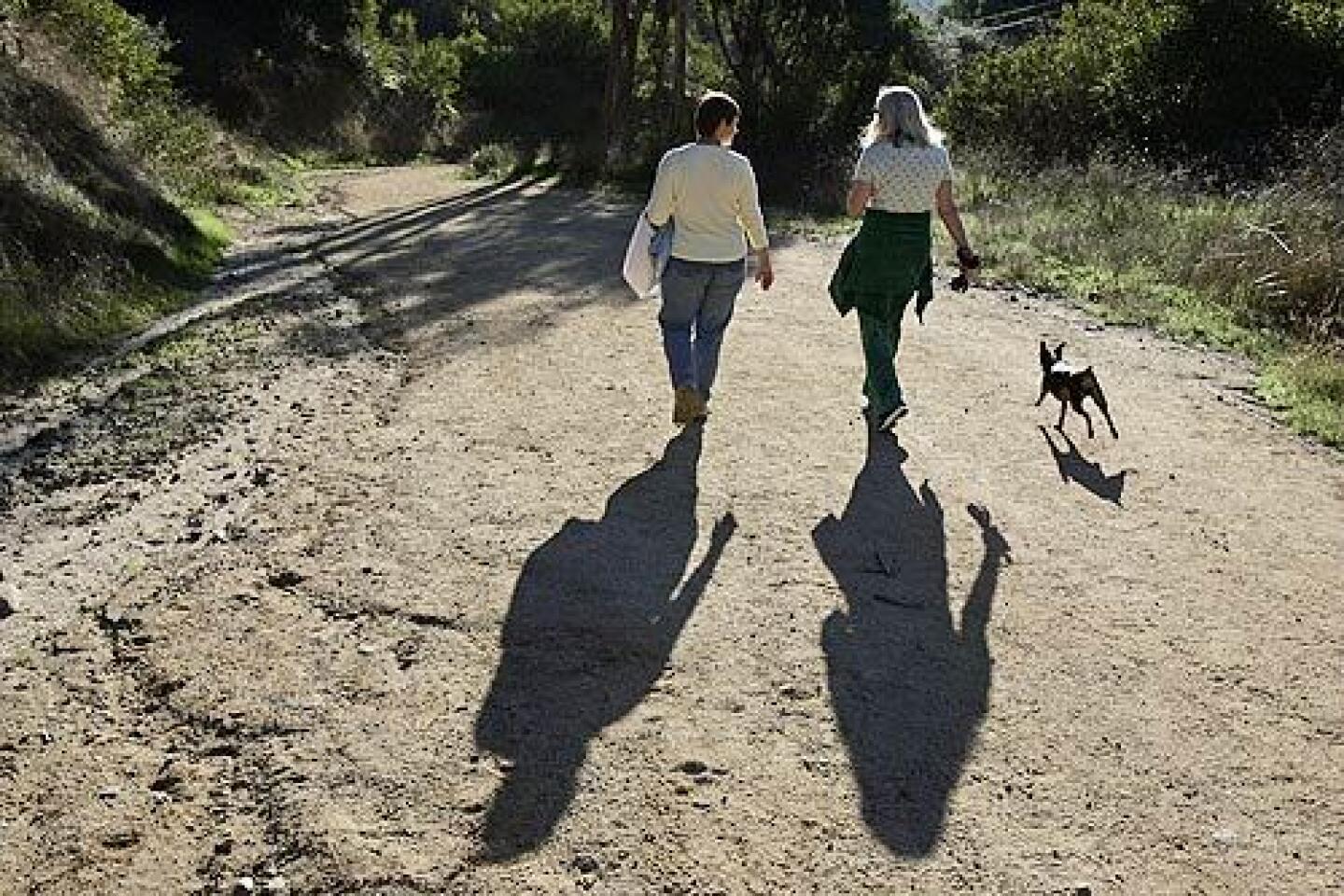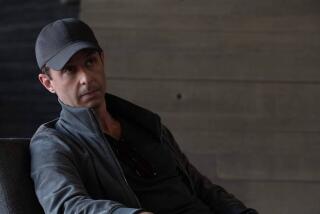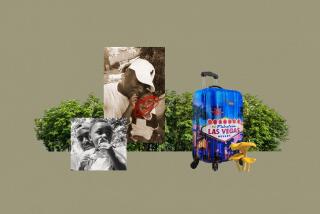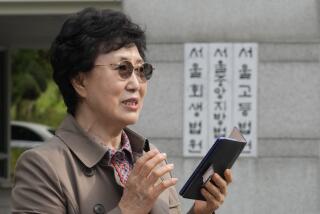Negotiating the difficulties of a delicate pact
IT WAS A SATURDAY, midmorning. A telephone split the stillness.
Kendall McArthur’s adoptive mother, Dorothea, known as Dorrie, took the call in the study. In an instant, more than two years of turmoil crested, then crashed in Kendall’s heart. It was her birth mother.
Kendall, 11, dismissed a playmate. She crept to the study door, just out of sight, and listened intently. Within moments, the conversation grew heated. Kendall had neither seen nor spoken with her birth mother, Patti Sheets, in what seemed like forever.
There was biting anger in Dorrie McArthur’s voice as it tumbled out of the study and into Kendall’s elegantly appointed Silver Lake home. Kendall caught every word, and she filled in the silences with good guesses about what her birth mother was saying on the other end: I want to see Kendall.
She thought this might happen. Her birth mother had called three weeks before, for the first time in 27 months. She had spoken with Dorrie — but not with Kendall, who had been deeply hurt by her absence. Kendall had already insisted on conditions for a visit: Patti must see a psychologist, just as Kendall was doing. She must figure out why she had disappeared from Kendall’s life. She must explain it, and she must promise never to vanish again. Barring that, Kendall said, even if Patti appeared at her door, she would hide in a closet and refuse to see her.
On the phone in the study, Kendall’s adoptive mother was spelling this out again. Last time, the conditions had met with stony silence. Now there was fury.
Maybe it was over. For six years, Kendall had been in an open adoption, a delicate arrangement by which children see their birth parents often — at least several times a year, sometimes weekly, even daily. By agreement, both sets of parents — adoptive and biological — play large roles in their children’s lives.
Forty years ago, most adoptions in the United States were closed. Today, about 25% are completely open. Most of the rest are at least partly open, with varying degrees of communication between birth families and adoptive parents. But the arrangement can be contentious. Some adoptive parents fear that bonding with children will be harder if birth parents are around. Others are convinced that children benefit if they know their birth parents well.
Kendall’s adoptive parents, Dorrie McArthur, a practicing psychologist, 52, and her husband David, 48, now an epidemiologist engaged in brain trauma research at UCLA, wanted this adoption to be as open as possible. Ever since Kendall could remember, open adoption had forced her to struggle with both of her families. At the same time, however, it helped her understand her roots. More important, it was showing her that being adopted was not her fault.
Nonetheless, Kendall was afraid that she might be rejected again, by one set of parents or the other, and her birth mother’s disappearance for the last two years had not helped. During that time, Patti Sheets had rejoined the Army, become a Patriot missile operator at Ft. Bliss in El Paso, and prepared to divorce for the third time. If this open adoption was going to work, Spc. Sheets, 34, had to promise to stay in touch.
As Dorrie McArthur set out Kendall’s prerequisites for a visit, Patti exploded in anger. One thought raced through Patti’s mind: I’m not buying Dorrie’s bull. “You’re a shrink,” she said. “You know how to play shrink games, and I want to see her before I go.”
Dorrie recalled replying tartly that Patti was the one who had disappeared. It had hurt Kendall, and it had wiped out the benefits of open adoption.
Kendall, deadly quiet, listened.
Patti retorted: If Dorrie wanted an open adoption, she had to consider Patti’s feelings and needs as well as those of her other children. Patti would not reopen the adoption on what she considered to be Dorrie’s — not Kendall’s — terms. She would see Kendall on neutral ground in a public place: Wild Animal Park in San Diego County, where Patti was visiting her father and her mother. No therapy. Take it or leave it.
Dorrie said she had the legal rights to Kendall.
Kendall sensed that her adoptive mother was about to hang up. She might never see her birth mother or her half-brother and half-sister again, and she would miss them terribly. Quickly, she stepped out from behind the study door. She shook her head violently and mouthed three words.
Dorrie could not understand.
Kendall was frantic. She seized a piece of paper and mouthed the words again. She held up the paper so her adopted mother could see.
“Let her come.”
An epiphany
DORRIE, DAVID AND KENDALL drove to San Diego. They spent four hours with Patti at the animal park, riding the trolley and ooohing and aaahing at lions, giraffes and hyenas. Patti offered not a word about leaving for two years without saying goodbye.She talked about turning her life around. She talked about the Army; she might be sent to South Korea. Moreover, in the aftermath of the Persian Gulf War, she was on 96-hour notice to ship out to Saudi Arabia if her unit was needed there instead. She said she was worried about leaving her other two children, Jed and Bryhannah, now 14 and 8, with a sister in Lynnwood, Wash., for nearly a year.
She talked far less about Kendall: Was her hair naturally curly?
As they left the park, Patti gave Kendall a key chain for her 12th birthday, four weeks away. She made no promises about the future, only that if she went to South Korea, she would try to send Kendall something.
For several days, Kendall held the key chain closely, even slept with it. But then she lost it. Like her birth mother, the key chain was gone.
Kendall had a nightmare. She was playing at a friend’s house, and a policeman came to arrest her because, like her birth mother, she was Jewish. She pleaded with him and assured him that she lived with a Christian family. The policeman dragged her away, but Kendall fervently believed that Dorrie and David would rescue her.
As Kendall edged toward teen age, she blossomed athletically. She excelled at dancing and gymnastics. Dorrie took her to an equestrian center, where she was a natural. She rode horses instinctively, fearlessly. Dorrie pointed out that Leo Tremblay, whom everyone now recognized as her birth father, had grown up on a horse farm in Palmdale.
It was an epiphany.
“Oh, my God!” Kendall said.
Open adoption had helped the McArthurs discover crucial information about Kendall’s birth parents. Tremblay, by his own account, was an alcoholic, so they encouraged her to spend time at the stables, away from friends who were starting to drink and use drugs. Dorrie and David bought her a thoroughbred horse named Czar.
Kendall’s love for Czar was steadfast, uncomplicated and unconditional. She groomed him faithfully. “Mom,” she said almost every day, “get me to the ranch.”
Her love for her adoptive parents, however, was tortuous. She could be loving, cheerful, affectionate — and then become what Dorrie called an “adolescent plus.”
On her birthdays or during any event that signified change, Kendall seemed to search for things to grow angry about. She seemed to want her adoptive mother to explode — and to find out what happened next: Would Dorrie still be there for her? Kendall ranted and bossed her parents. During their worst fights, Kendall would spit in Dorrie’s face. “You are not my real mother!”
Patti saw a child pleading for limits. Dorrie disagreed. She thought these episodes — storms that descended after months of calm — were driven by fear. She knew that many adoptees felt rejected and were haunted by insecurity. She knew that this insecurity drove Kendall 1) to push her adoptive parents hard to see if they would give her away, just as her birth parents had, and 2) to strike preemptively — kick herself out — before her adoptive parents could.
Dorrie told Kendall again and again that no matter how badly she acted, she and David would never leave her, never stop loving her.
Patti resumed visits — but then was posted to South Korea. She left Kendall’s half-siblings, Jed and Bryhannah, with a man who had just become her fourth husband.
Often after fights with Dorrie, Kendall called Patti her mom and Dorrie by her first name. It made Patti wonder, even from across the Pacific, if Kendall was playing her mothers against each other. She worried about Kendall and her adolescent rants. Patti told herself: You placed Kendall with this family. You chose the wrong family. “Oh, my God,” Patti said to a friend. “What have I done to this child?”
At age 15, Kendall told Patti that she wanted to live with her. “If I just come there, what would you do?”
Patti replied that she could not come to her until she was 18 and independent. At 18, and only then, would the door be open.
Patti figured that she owed it to Dorrie to tell her.
She warned: “I am afraid that Kendall will leave you completely when she turns 18 and never come back.”
The possibility grew into a central prospect of Kendall’s life.
Asserting independence
FOR KENDALL, the prospect of joining Patti was heightened by heredity.Kendall lagged developmentally. Because of a learning difficulty, she was flunking. Dorrie enrolled her in a school that met only in the mornings. It was for children focused on acting and dancing. Three of Kendall’s four adoptive grandparents had graduated from Harvard or Radcliffe, but now Dorrie and David faced a crushing reality: Kendall might not go to college.
Kendall, for her part, felt stupid around her parents and uncomfortable with the children of her parents’ friends, many of whom were at the top of their classes.
“You got the wrong kid,” she joked to her adoptive mother, on the square.
Three times, Patti invited Kendall to visit her. In her responses, Kendall struggled to assert her independence from both of her families.
One invitation came when Kendall was 16. Patti was at home in El Paso, on a 30-day leave from South Korea. The McArthurs, already counting the days to Kendall’s 18th birthday, went with her. Jed and Bryhannah turned the visit into a tug-of-war over Kendall. “Come live with us,” Bryhannah begged. To woo Kendall away, she lied to her about Dorrie and David. Bryhannah told herself that all of her problems would disappear if only her big sister stayed.
Part of Kendall wanted to stay, too. She felt guilty about the stability she enjoyed with the McArthurs. In a voice filled with anger, she told Jed and Bryhannah that Patti had, in fact, abandoned them when she left them behind — twice — for military obligations.
Dorrie and David said no, Kendall couldn’t stay with her birth family, even for a few days. Back home in Silver Lake, Kendall told Dorrie that she disliked her because she was so different. But later that week, Kendall crawled into her mother’s lap while they watched television. Dorrie rubbed Kendall’s back. “Izzy de mama?” Kendall asked. She still used baby talk — “are you my mother?” — when she needed reassurance.
The second invitation from Patti came just before Kendall turned 17. Her birth mother was back in El Paso again, on her way to a three-year posting in Germany. She offered to buy Kendall a plane ticket to Texas. This time, the invitation was for her alone.
Dorrie told herself that she had to say yes to the visit. It was the right thing; Kendall belonged to Patti too. Besides, if she couldn’t go, she would be more likely to rebel and run to Patti forever in another year, when she was 18.
At LAX, Kendall refused a hug. As she walked away, Dorrie wept.
Kendall’s return flight was scheduled in three days. She phoned: Something was wrong with the plane. The next day, she called again: Another airplane delay. “Enough already,” Dorrie said firmly.
Bryhannah begged Kendall to stay forever.
But Kendall came back home.
Before the third invitation, the ambivalence in Kendall’s heart exploded. She had an opportunity to meet her paternal grandmother. Her birth father would not be there; her grandmother had kicked him off the family horse farm for hitting a ranch hand. The night before the visit, Kendall staged what Dorrie and David recognized as one of the biggest tests of their love.
All three would later agree on what happened.
Kendall refused to turn down her radio. David unplugged it. Kendall took his wallet from his bedroom. He dumped the contents of her purse, then her chest of drawers. “I need my wallet back!” he said. Kendall packed to leave, but David locked the front door. Kendall stomped into her bedroom, screaming and flailing her arms. Dorrie and David pinned her on her bed.
“You ----ing bitch!” Kendall screamed at Dorrie.
Kendall kicked wildly. One foot smacked Dorrie’s face, bruising her right eye. Dorrie sat on top of her daughter and held her arms. David held her legs.
“I’m never going to come back here!” Kendall shouted. “I’m out of here! I’m an adult! You can’t treat me like a child!”
Dorrie promised to treat her as a grown-up, but said that if she ever tried to hurt her parents again, they would defend themselves. Dorrie and David held her on the bed for half an hour, until she calmed down.
“Don’t you ever touch me again,” Kendall said.
“Don’t give me a reason to,” Dorrie said.
The third invitation to visit Patti came in August 2001. Kendall could fly to Germany for the Christmas holidays, a gift for her 18th birthday that October. Patti told Kendall to ask Dorrie’s permission. Kendall said it was OK — with such certainty that Patti thought there was no need to check.
Kendall told Dorrie that she might visit Patti for a week or two and reminded her that Patti had said she could live with her when she turned 18.
Patti bought a $560 nonrefundable ticket.
Then Kendall changed her mind. She told Dorrie she didn’t want to go. She didn’t want to leave her horse, she couldn’t speak German and the terrorist attack on the World Trade Center that September had made air travel nerve-racking.
Kendall finally told Patti she wasn’t coming — and blamed it all on Dorrie. “I really want to come, but my mom said no.”
Patti erupted in anger.
Hadn’t Dorrie always said that when Kendall turned 18, she could make her own decisions? Now Patti had lost $560. She was furious with Kendall too. She suspected that Kendall had not told Dorrie the whole truth. Had Kendall told both of her mothers only what they wanted to hear?
But Patti blamed Dorrie more. “That bitch!” she told her own family in Germany. She vowed never to speak to Dorrie again.
So it was that Kendall stayed with her adoptive parents for her 18th birthday and beyond. She got no Christmas gift from her birth mother, and on Christmas Day her birth mother refused to talk to her.
Meeting the birth father
KENDALL HAD GROWN CLOSE to a woman at the stables. Donna Simons, 43, and Patti were roughly the same age. Both had been divorced at least twice. Both had suffered domestic violence. Both had relied sporadically on welfare. Both had one child older and another child younger than Kendall. Privately, Dorrie and David called Donna the “local birth mother.”One day, while Dorrie and David sang the “Fauré Requiem” with the Pasadena Pro Musica Choir, Donna and a new boyfriend took Kendall for a ride on a Harley-Davidson. Not only was Donna a horsewoman, but she was also a former “Baywatch” extra and catered food on the sets of pornographic movies.
It was Donna, not her adoptive parents, whom Kendall wanted on hand when her second horse arrived — Luckington Monarch, a shire from England, jet black, more than 18 hands tall. The McArthurs had bought him for Kendall for $8,000. Boarding and training Monarch and Czar cost Dorrie and David $1,600 a month.
High school finally overwhelmed Kendall, and she dropped out. Dorrie told her she had to train for a profession with horses or find a job.
At first, Kendall took heed. She focused on Czar and Monarch and trained full time. At horse shows — where she would kneel, riding no-hands, on a cantering gelding — she earned fistfuls of ribbons. At a competition in Santa Barbara, she performed a choreographed routine with three other teenagers to win their division and become the nation’s best in class.
Then, in March 2002, Kendall finally met her birth father.
It was exciting but frightening. Leo Tremblay was 43. Nearly blind, he lived on disability in a small house in Tehachapi. As well as his instinct for horses, Kendall seemed to have his sense of humor, his hands, his darting glances and olive skin. By his own count, he had been arrested four times on suspicion of drunk driving, gone to jail once and fathered four children, some out of wedlock.
It shocked Kendall, but not as much as Kendall shocked Dorrie eight months later. Kendall came home one day and said that she had been offered money if she would let Monarch be used in pornography. An actress would pose naked on him.
“The McArthurs don’t do porn,” Dorrie replied, succinctly. “Including the animals.” If Kendall went through with this, the McArthurs said, they would cut off her financial support, including board for her horses — and she would have to find another home.
Furious, Kendall, now 19, packed her bags and left.
Dorrie wrote to her at Donna’s home: Living with the McArthurs and with Donna Simons was not working; Kendall must choose. “Most important,” Dorrie added, “is that we love you always have always will. Nothing can ever change that.”
Within four months, Kendall had moved in with Devin Coury, 41, one of Donna’s ex-boyfriends. Devin, like Kendall’s birth father, was loud, swaggering and liked to party. He had been a musician, a bodybuilder and a Chippendales dancer known as Fabio, with flowing blond hair and a pink G-string. Now he was a bouncer at a strip joint.
By his own account, Devin had become a crack addict in his 30s. When he and Kendall met, he was four months out of prison on drug charges. He had been in rehab, relapsed and was back on crack again, as well as GHB, a painkiller for a back injury he sustained in a dirt-bike accident.
Kendall found him attractive, kind-hearted. She followed him to the beach, to the gym and to his Alcoholics Anonymous meetings.
Devin introduced her to a hazardous life. Within a year, Kendall had begun using crack. One night in June 2003, she suffered a seizure and stopped breathing. He resuscitated her and got her to a hospital.
When she recovered, they rented a room in Donna’s house.
Dorrie was amazed at how Kendall had collected a friend and a boyfriend — who had once dated each other — and created a family so similar in some ways to her birth family. Dorrie thought that Kendall believed, or at least hoped, that this family would not put her up for adoption.
Psychobabble, Kendall thought. She hated it when Dorrie said that Donna was like Patti, and that Devin was like her birth father. “My boyfriend,” she said, “is my boyfriend.”
Kendall and Devin argued often, until Donna kicked them out. For days, they lived in Devin’s pickup truck. Desperate, Kendall asked her adoptive parents to take them in.
Dorrie insisted that she leave Devin first.
By now, Patti had returned from her Army posting in Germany. Kendall called her in El Paso. Could she and Devin move in with her?
Kendall’s birth mother balked. She had her hands full. Jed had gone Goth: He wore black dresses, makeup and a mohawk. He was calling himself an “equal-opportunity hater.” Angry at Patti about his unstable childhood, he rammed his fist through a wall of their apartment. Bryhannah had hated Germany. At night, she sneaked out of her mother’s house and drank tequila sunrises at a GI bar until dawn.
What if Kendall and Devin did even worse?
Kendall admitted to stealing from the McArthurs. It was petty theft, but it added to Patti’s shame. Then Patti found out that Kendall had been auditioning for pornographic photos. Now Patti felt both shame and guilt. Would Kendall be doing these things if she hadn’t given her up for adoption?
One night in February 2004, after Kendall turned 20, Devin hemorrhaged from stomach damage caused by painkillers. The next month, he quit drugs cold turkey. Six days later, he suffered violent seizures. He left the hospital partly paralyzed and with memory loss. He urged Kendall to go back to her family in Silver Lake, but Kendall stuck by him.
She nursed him day and night for seven months. Together, they hit bottom. Soon both were on the streets again.
Another blue-eyed baby
THIS TIME, Kendall’s adoptive father gave in. David told Dorrie that he was bringing them home. But Dorrie set conditions: 1) No drugs. 2) The arrangement was temporary. 3) They had to pitch in: shop for groceries and cook the family meal each night.
Gradually, the contention between Kendall and her adoptive parents seemed to ease.
For her 21st birthday, Dorrie gave Kendall a bed. The passage of time had made it easier for Kendall to tell Dorrie that she loved her. One day, she gave Dorrie a warm hug. Even Patti noticed that Kendall seemed to have stopped rebelling. By now, she had done some of the worst things possible, and it was clear that Dorrie and David still loved her.
Coexistence at home in Silver Lake, though, was difficult. Drug abuse had taken a toll on Devin; his back problems worsened. Dorrie and David were not fond of the man who had introduced their daughter to drugs, but they tried to help. David sought a top physician at UCLA, who operated on Devin’s back.
He recovered, but Kendall began suffering bouts of nausea.
She learned that she was pregnant.
At dinner, Dorrie and David congratulated their daughter and her boyfriend, but voiced some concerns. Apart from Devin’s disability check, they had no income. Dorrie said she wanted to be the baby’s grandparent — not its parent.
One day, Kendall called Devin to dinner, where Dorrie and David were waiting. David found him naked and unconscious. He had used GHB.
Kendall begged Dorrie and David not to kick him out. “I love him,” she pleaded. But she told Devin they might have to break up. As she neared her due date, she searched the Internet and printed out biographies and photos of 20 prospective adoptive parents. Angrily, she handed him the information.
If Kendall gave up the baby, he said, he would leave her. “I’m out of here.”
Dorrie and David said they would support any decision she made.
Kendall called Patti, grateful that she could ask questions of someone who had been pregnant. How long did morning sickness last? What was labor like? Patti answered her questions and advised her to do what was best for her child.
If she decided on adoption, Kendall told everyone, then it would be an open adoption — just like her own.
“Open adoption really helped me understand who I am — where I came from, why I am the person I am,” she said. It had helped her know she hadn’t been rejected because something was wrong with her. She could ask Patti herself over and over: Why had Patti given her up? Over and over, Patti could explain: She put Kendall up for adoption for Kendall’s own good.
Knowing this did not take away a sense of loss, but because of open adoption, she felt loved by both of her families. Without open adoption, she might never have known that love.
At 8 1/2 months, doctors performed a Caesarean section. Kendall’s baby was a tiny blue-eyed girl. She weighed 6 pounds, 1 ounce. She had Kendall’s nose, puffy chipmunk cheeks and pointy lips and Devin’s frown, ears and eyebrows.
They named her Kaitlyn Rose.
Kendall ventured to the neonatal unit. She looked at her daughter. She had shocks of fuzzy brown hair. In an instant she understood how difficult it had been for Patti to walk away from her. Kendall could not imagine doing it.
She took her baby home.
Achieving the goal
KENDALL MCARTHUR BECAME a sweet, loving, doting mother. Devin Coury, drug-free for three years and now her fiance, became an adoring father who works as a personal trainer.
As a mom, Kendall would not let anyone baby-sit Kaitlyn Rose. She almost never let anyone hold her. Maybe, she thought, it was because she had been separated from her birth mother when she was even younger than Kaitlyn. She wrapped her baby in a pink blanket and took her everywhere.
She credited Dorrie for teaching her how to be attentive and loving.
In November 2005, Patti came to visit. She and her husband had moved to Atlanta and owned a home there, as well as one in El Paso. Patti was now a staff sergeant. She managed a dental clinic at Ft. McPherson. She and her husband earned more than $125,000 a year and had a time-share in Sedona, Ariz. They owned five acres in Tennessee, for their retirement.
During her visit, she and Dorrie walked in Griffith Park and along the Los Angeles River. They spoke honestly about their past complaints, fears and misunderstandings. They agreed that they had achieved the goal of open adoption: Kendall was in contact with both of her families and drew love and support from both.
Dorrie put a hand on Patti’s shoulder and thanked her for the most important gift of her life. “I am sorry that some of the parenting I did made you feel bad.”
Patti whispered through tears: “Thank you for taking care of her. I know you did what you felt was best.”
They hugged, long and deeply.
On the night before Patti left, Kendall had dinner with her birth mother and her adoptive mother. They sat around a wooden table in Dorrie’s dining room.
Afterward, Dorrie and Kendall washed the dishes together. Kendall no longer blamed herself for Patti’s decision: If Patti had been this stable all along, Kendall said, she never would have given her away.
But then, she added, smiling: “I would not have been able to live with you.”
sonia.nazario@latimes.com
-
(INFOBOX BELOW)
Challenges of adoption
About 2.5% of U.S. children are adopted. Adoption usually moves a child up the socioeconomic ladder, but by school age, adoptees are at greater risk for a variety of behavioral, emotional and academic problems than other children.
Family income*
Of children who were . .
....not adopted
$35,000 or less: 17%
$65,000 or more: 44%
...adopted as infants
$35,000 or less: 3%
$65,000 or more: 75%
...adopted from another country
$35,000 or less: 2%
$65,000 or more: 73%
...adopted from foster care
$35,000 or less: 56%
$65,000 or more: 14%
Problems of adopted children
--
Percent of school-age children who have . .
....a learning disability
Not adopted: 6%
Adopted as infants: 26%
Adopted from another country: 27%
Adopted from foster care: 47%
...seen a counselor for behavioral/emotional problems
Not adopted: 18%
Adopted as infants: 41%
Adopted from another country: 45%
Adopted from foster care: 54%
...taken medication for behavioral/emotional problems
Not adopted: 4%
Adopted as infants: 30%
Adopted from another country: 22%
Adopted from foster care: 31%
...used special education services
Not adopted: 9%
Adopted as infants: 24%
Adopted from another country: 32%
Adopted from foster care: 40%
--
*Annual income of the biological family in the case of children who were not adopted and of the adoptive family in all other cases.
Source: Illinois State University: A Comparative Study of Child Welfare Adoptions and Other Types of Adopted Children and Birth Children (2004)
Graphics reporting by Sonia Nazario
More to Read
Sign up for Essential California
The most important California stories and recommendations in your inbox every morning.
You may occasionally receive promotional content from the Los Angeles Times.
